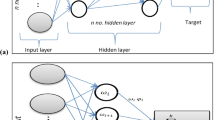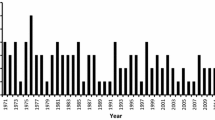Abstract
An attempt is made in this study to forecast the central pressure drop (PD) and maximum sustained wind speed (MSWS) associated with cyclonic systems at the stage of the highest intensity over Arabian Sea using artificial neural network models. The cyclonic systems include the phases from deep depression to extreme severe cyclones. The sea surface temperature, mid-tropospheric relative humidity, surface to middle tropospheric equivalent potential temperature gradient, inverse of wind shear and vertical wind velocity at 200 hPa level are evaluated as the most suitable predictors through principal component analysis. Various neural network models with different architectures have been trained with the data from 1990 to 2012 to select the best forecast model. The prediction skill of the intelligent models is evaluated by different accuracy measures. The results show that the multi-layer perceptron (MLP) model with five input layers, one hidden layer with four nodes and one output layer is the best model for forecasting PD with minimum prediction error of 0.14 at 36 h lead time, whereas the MLP model with five input layers, one hidden layer with five nodes and one output layer is found to be the best model for forecasting MSWS with minimum prediction error of 0.19 at 48 h (h) lead time. The results are well validated with the observations from 2013 to 2018. The forecast skill of MLP model is compared with multiple linear regression model and existing operational and numerical weather prediction models.















Similar content being viewed by others
Abbreviations
- ANN:
-
Artificial neural network
- AS:
-
Arabian Sea
- BOB:
-
Bay of Bengal
- BW:
-
Box Whisker
- CS:
-
Cyclonic storm
- DD:
-
Deep depression
- EPTD:
-
Equivalent potential temperature difference
- ESCS:
-
Extreme severe cyclonic storm
- GRNN:
-
Generalized regression neural network
- IMD:
-
Indian Meteorological Department
- IQR:
-
Inter-quartile range
- IWS:
-
Inverse of wind shear
- K:
-
Kelvin
- LLV:
-
Low-level vorticity
- MAE:
-
Mean absolute error
- MLP:
-
Multilayer Perceptron
- MLR:
-
Multiple linear regression
- MRH:
-
Mid-tropospheric relative humidity
- MSWS:
-
Maximum Sustained Wind Speed
- NIO:
-
North Indian Ocean
- PC:
-
Principal component
- PCA:
-
Principal component analysis
- PD:
-
Pressure Drop
- PE:
-
Prediction error
- PI:
-
Potential intensity
- RBFN:
-
Radial basis function network
- RMSE:
-
Root mean-square error
- SCS:
-
Severe cyclonic storm
- SD:
-
Standard deviation
- SST:
-
Sea surface temperature
- TC:
-
Tropical cyclone
- VSCS:
-
Very severe cyclonic storm
- WRF:
-
Weather Research and Forecasting
References
Atlas R, Hoffman RN, Ardizzone J, Leidner SM, Jusem JC, Smith DK, Gombos D (2011) A cross-calibrated, multiplatform ocean surface wind velocity product for meteorological and oceanographic applications. Bull Am Meteorol Soc 92:157–174
Bister M, Emanuel KA (2002) Low frequency variability of tropical cyclone potential intensity. 1. Interannual to inter decadal variability. J Geophys Res-Atmos 107:4801. https://doi.org/10.1029/2001JD000776
Bose NK, Liang P (1995) Neural network fundamentals with graphs, algorithms and applications. McGraw Hill International Edition, The MIT Press, Cambridge
Chaudhuri S (2010) Convective energies in forecasting severe thunderstorms with one hidden layer neural net and variable learning rate back propagation algorithm. Asia-Pac J Atmos Sci 46(2):173–183
Chaudhuri S, Chowdhury AR (2018) Air quality index assessment prelude to mitigate environmental hazards. Nat Hazards 91:1–17
Chaudhuri S, Middey A (2011) Adaptive neuro-fuzzy inference system to forecast peak gust speed during thunderstorms. Meteorol Atmos Phys 114:139–149
Chaudhuri S, Middey A, Goswami S, Banerjee S (2012) Appraisal of the prevalence of severe tropical storms over Indian Ocean by screening the features of tropical depressions. Nat Hazards 61(2):745–756
Chaudhuri S, Dutta D, Goswami S, Middey A (2013) Intensity forecast of Tropical Cyclones over North Indian Ocean using multi-layer perceptron model: skill and performance verification. Nat Hazards 65:97–113
Chaudhuri S, Dutta D, Goswami S, Middey A (2014a) Track and intensity forecast of tropical cyclones over the North Indian Ocean with multilayer feed forward neural nets. Meteorol Appl 22:563–575
Chaudhuri S, Goswami S, Middey A (2014b) Medium-range forecast of cyclogenesis over North Indian Ocean with multilayer perceptron model using satellite data. Nat Hazards 70:173–193
Chaudhuri S, Basu D, Das D, Goswami S, Varshney S (2017) Swarm intelligence and neural nets in forecasting the maximum sustained wind speed along the track of tropical cyclones over Bay of Bengal. Nat Hazards 87:1413–1433
Chavas DR, Reed KA, Knaff JA (2017) Physical understanding of the tropical cyclone wind-pressure relationship. Nat Commun 8(1):1–11
Comrie AC (1997) Comparing neural networks and regression models for ozone forecasting. J Air Waste Manage 47:653–663
Das AK, Rao YR, Tallapragada V, Zhang Z, Bhowmik SR, Sharma A (2015) Evaluation of the Hurricane weather research and forecasting(HWRF) model for tropical cyclone forecasts over the North Indian Ocean (NIO). Nat Hazards 75:1205–1221
DeMaria M (1996) The effect of vertical shear on tropical cyclone intensity change. J Atmos Sci 53:2076–2087
DeMaria M, Kaplan J (1994) Sea surface temperature and the maximum intensity of Atlantic tropical cyclones. J Climate 7:1325–1334
Emanuel KA (1987) The dependence of hurricane intensity on climate. Nature 326:483–485
Emanuel K (2000) A statistical analysis of tropical cyclone intensity. Mon Weather Rev 128:1139–1152
Emanuel K (2007) Environmental factors affecting tropical cyclone power dissipation. J Clim 20(22):5497–5509
Fletcher R (1955) Computation of maximum surface winds in hurricanes. Bull Am Meteor Soc 36:247–250
Gardner MW, Dorling SR (1998) Artificial neural networks (the multilayer perceptron)—a review of applications in the atmospheric sciences. Atmos Environ 32:2627–2636
Gray WM (1968) Global view of the origin of tropical disturbances and storms. Mon Wea Rev 96(10):669–700
Gray WM (1975) Tropical cyclone genesis. Dept. of Atmos. Sci. Paper 234, Colorado State University, Fort Collins, CO, 121 pp
Gray WM (1998) The formation of tropical cyclones. Meteorol Atmos Phys 67:37–69
Grossman DN, David MN, Mary CF (1991) Principal component analysis of assemblage structure data: utility of tests based on eigenvalues. Ecology 72:41–347
Haykin S (1999) Neural networks, a comprehensive foundation, 2nd edn. Prentice-Hall, Englewood Cliffs
Hobgod JS (1998) The effects of climatological and persistence variables on the intensities of Tropical Cyclones over the Eastern North Pacific Ocean. Weather Forecast 13:632–639
Hornik K (1991) Approximation capabilities of multi-layer neural networks. Neural Networks 4(2):251–257
Hsieh WW, Tang B (1998) Applying neural network models to prediction and data analysis meteorology and oceanography. Bull Am Meteorol Soc 79:855–1870
Kaiser HF (1960) The application of electronic computers to factor analysis. Educ Psychol Meas 20:141–151
Kalnay E, Kanamitsu M, Kistler R, Collins W, Deaven D, Gandin L, Iredell M, Saha S, White G, Woollen J, Zhu Y, Chelliah M, Ebisuzaki W, Higgins W, Jaccnowiak J, Mo KC, Ropelewski C, Wang J, Leetmaa A, Reynolds R, Jenne R, Joseph D (1996) The NCEP/NCAR 40-year reanalysis project. Bull Am Meteorol Soc 77:437–471
Kotal SD, Roy Bhowmik SK (2011) A Multimodel Ensemble (MME) technique for cyclone track prediction over the North Indian Sea. Geofizika 28:275–291
Kotal SD, Roy Bhowmik SK, Kundu PK (2008a) Application of statistical-dynamical scheme for real time forecasting of the Bay of Bengal very severe cyclonic storm" SIDR" of November 2007. Geofizika 25(2):39–158
Kotal SD, Roy Bhowmik SK, Kundu PK, Das AK (2008b) A statistical cyclone intensity prediction (SCIP) model for the Bay of Bengal. J Earth Sc System 117(2):157–168
Kotal SD, Kundu PK, Roy Bhowmik SK (2009) An analysis of sea surface temperature and maximum potential intensity of tropical cyclones over the Bay of Bengal between 1981 and 2000. Met Appl 16(2):169–177
Kotal SD, Bhattacharya SK, Roy Bhowmik SK, Kundu PK (2015) Verification of forecasts of IMD NWP based cyclone prediction system (CPS) for cyclones over the north Indian seas during 2013. Mausam 66(3):497–510
Kotal SD, Bhattacharya SK, Roy Bhowmik SK (2019) Estimation of tropical cyclone intensity and location over the north Indian Ocean–a challenge. Met Appl 26(2):245–252
Liu MQ (2006) Discrete-time delayed standard neural network model and its application. Sci China Inform Sci 49(2):137–154
Mohanty UC, Osuri KK, Pattanayak S (2013) A study on high resolution mesoscale modeling systems for simulation of tropical cyclones over the Bay of Bengal. Mausam 64:117–134
Mohanty UC, Osuri KK, Tallapragada V, Marks FD, Pattanayak S, Mohapatra M, Gopalakrishnan SG, Niyogi D (2015) A great escape from the Bay of Bengal ‘Super Sapphire- Phailin’ tropical cyclone—a case of improved weather forecast and societal response for disaster mitigation. Earth Interact 19(17):1–11
Mohapatra M, Sharma M (2019) Cyclone warning services in India during recent years: a review. Mausam 70(4):635–666
Mohapatra M, Bandyopadhyay BK, Nayak DP (2013a) Evaluation of official tropical cyclone intensity forecast over north Indian Ocean issued by India Meteorological Department. Nat Hazards 68:433–451
Mohapatra M, Sikka DR, Bandyopadhyay BK, Tyagi A (2013b) Outcomes and challenges of Forecast Demonstration Project (FDP) on landfalling cyclones over Bay of Bengal. Mausam 61(1):1–12
Nadimpalli R, Osuri KK, Pattanayak S, Mohanty UC, Nageswararao MM, Prasad SK (2016) Real-time prediction of movement, intensity and storm surge of very severe cyclonic storm Hudhud over Bay of Bengal using high-resolution dynamical model. Nat Hazards 81(3):1771–1795
Ngia NGIA (2012) South Atlantic Ocean and Indian Ocean—Sailing directions. In: Agency NGI (ed) Tenth edn. Springfield, Virginia.
Park J, Sandberg IW (1991) Universal approximation using radial-basis function networks. Neural Comput 3(2):246–257
Pattanayak S, Mohanty UC (2008) A comparative study on performance of MM5 and WRF models in simulation of tropical cyclones over Indian seas. Curr Sci 95:923–926
Reynolds RW, Smith TM, Liu C, Chelton DB, Casey KS, Schlax MG (2007) Daily high-resolution-blended analyses for sea surface temperature. J Climate 20:5473–5496
Roy C, Kovordányi R (2012) Tropical cyclone track forecasting techniques—a review. Atmos Res 104–105:40–69
Tuleya RE, Kurihara Y (1981) A numerical study on the effects of environmental flow on tropical storm genesis. Mon Wea Rev 109:2487–2506
Wang Y, Wu CC (2004) Current understanding of tropical cyclone structure and intensity changes—a review. Meteo Atmos Phys 87:257–278
Acknowledgements
The corresponding author acknowledges the Space Application Centre, ISRO for providing the opportunity to work for SCATSAT 1 Application.
Author information
Authors and Affiliations
Corresponding author
Additional information
Responsible Editor: Clemens Simmer.
Publisher's Note
Springer Nature remains neutral with regard to jurisdictional claims in published maps and institutional affiliations.
Rights and permissions
About this article
Cite this article
Sarkar, I., Chaudhuri, S. & Pal, J. Artificial intelligence in forecasting central pressure drop and maximum sustained wind speed of cyclonic systems over Arabian Sea: skill comparison with conventional models. Meteorol Atmos Phys 133, 803–822 (2021). https://doi.org/10.1007/s00703-021-00777-2
Received:
Accepted:
Published:
Issue Date:
DOI: https://doi.org/10.1007/s00703-021-00777-2




